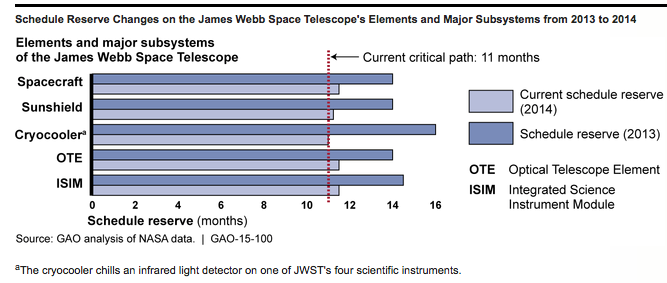[SatNews] JWST is one of NASA's most complex and expensive projects, at an anticipated cost of $8.8 billion.
What GAO (General Accounting Office) Found
With just under 4 years until its planned launch in October 2018, the James Webb Space Telescope (JWST) project reports it remains on schedule and budget. Technical challenges with JWST elements and major subsystems, however, have diminished the project's overall schedule reserve and increased risk. During the past year, delays have occurred on every element and major subsystem schedule—especially with the cryocooler—leaving all at risk of negatively impacting the overall project schedule reserve if further delays occur.

The project reports its overall schedule reserve is above its plan and standards. However, JWST is one of the most complex projects in the National Aeronautics and Space Administration's (NASA) history and has begun integrating and testing only two of the five elements and major subsystems. As such, maintaining as much schedule reserve as possible to navigate through almost 4 more years of integration and testing that remains, where prior work has shown problems are commonly found and schedules tend to slip, is critical. While the project has been able to reorganize work when necessary to mitigate schedule slips, this flexibility will diminish going forward. JWST is also facing limited short-term cost reserves to mitigate additional project schedule threats.
The JWST project and prime contractor's cost risk analyses used to validate the JWST budget are outdated and do not account for many new risks identified since 2011. GAO best practices for cost estimating call for regularly updating cost risk analyses to validate that reserves are sufficient to account for new risks. NASA officials said they conduct sufficient analysis to monitor the health of the budget. These efforts, however, do not incorporate potential impacts of risks identified since 2011 into estimates. While the project has subsequently agreed to conduct a cost risk analysis of the contract, it is important that they follow best practices, for example, by regularly updating that analysis. Doing so would provide the project with reliable information to gauge whether the contractor is at risk of future cost overruns.
Why GAO Did This Study
JWST is one of NASA's most complex and expensive projects, at an anticipated cost of $8.8 billion. With significant integration and testing planned until the launch date, the JWST project will need to address many challenges before NASA can conduct the science the telescope is intended to produce. GAO has made a number of prior recommendations to NASA, including in December 2012 that the project perform an updated joint cost and schedule risk analysis to improve cost estimates. NASA initially concurred with this recommendation, but it later indicated that the tracking of information it already had in place was sufficient and ultimately decided not to conduct another joint cost and schedule risk analysis.
GAO was mandated to assess the program annually and report on its progress. This is the third such report. This report assesses, among other issues, the extent to which (1) technical challenges are impacting the JWST project's ability to stay on schedule and budget, and (2) budget and cost estimates reflect current information about project risks. To conduct this work, GAO reviewed monthly and quarterly JWST reports, interviewed NASA and contractor officials, reviewed relevant policies, and conducted independent analysis of NASA and contractor data.
What GAO Recommends
Among other actions, NASA should follow best practices when updating its cost risk analysis to ensure reliability. In commenting on a draft of this report, NASA partially concurred with this recommendation.

